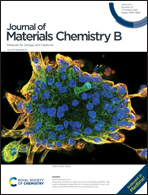Organotin Schiff bases as halofluorochromic dyes: green synthesis, chemio-photophysical characterization, DFT, and their fluorescent bioimaging in vitro†‡
Abstract
Fluorescent bioimaging is an excellent tool in cellular biology, and it will be a powerful technique in modern medicine as a noninvasive imaging technology where tumoral and normal cells must be distinguished. One of the differences between normal and cancer cells is the intracellular pH. Therefore, the design and synthesis of pH-responsive fluorescent materials are required. Organotin Schiff bases showed halofluorochromic behavior in solution. Microwave-assisted synthesis showed better reaction times and chemical yields compared with conventional heating. All compounds were fully characterized by spectroscopic and spectrometric techniques. The halofluorochromism study showed that some molecules in acidic media have the maximum luminescence intensity due to protonation. All the fluorescent tin complexes showed cell staining on hepatocyte and MCF-7 cells by confocal microscopy. The theoretical study has enabled us to rationalize the optical properties and the halofluorochromism for compounds 1 and 2 synthesized in this work. Our results showed that the emission decrease, in the acid and basic media for compounds 1 and 2, respectively, is caused by intramolecular charge transfer (ICT) deactivation.



 Please wait while we load your content...
Please wait while we load your content...